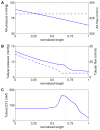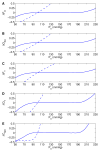Control and modulation of fluid flow in the rat kidney
- PMID: 24132579
- PMCID: PMC3870166
- DOI: 10.1007/s11538-013-9907-5
Control and modulation of fluid flow in the rat kidney
Abstract
We have developed a mathematical model of the rat's renal hemodynamics in the nephron level, and used that model to study flow control and signal transduction in the rat kidney. The model represents an afferent arteriole, glomerular filtration, and a segment of a short-loop nephron. The model afferent arteriole is myogenically active and represents smooth muscle membrane potential and electrical coupling. The myogenic mechanism is based on the assumption that the activity of nonselective cation channels is shifted by changes in transmural pressure, such that elevation in pressure induces vasoconstriction, which increases resistance to blood flow. From the afferent arteriole's fluid delivery output, glomerular filtration rate is computed, based on conservation of plasma and plasma protein. Chloride concentration is then computed along the renal tubule based on solute conservation that represents water reabsorption along the proximal tubule and the water-permeable segment of the descending limb, and chloride fluxes driven by passive diffusion and active transport. The model's autoregulatory response is predicted to maintain stable renal blood flow within a physiologic range of blood pressure values. Power spectra associated with time series predicted by the model reveal a prominent fundamental peak at ∼165 mHz arising from the afferent arteriole's spontaneous vasomotion. Periodic external forcings interact with vasomotion to introduce heterodynes into the power spectra, significantly increasing their complexity.
Figures










Similar articles
-
Theoretical assessment of renal autoregulatory mechanisms.Am J Physiol Renal Physiol. 2014 Jun 1;306(11):F1357-71. doi: 10.1152/ajprenal.00649.2013. Epub 2014 Mar 12. Am J Physiol Renal Physiol. 2014. PMID: 24623150 Free PMC article.
-
A multinephron model of renal blood flow autoregulation by tubuloglomerular feedback and myogenic response.Acta Physiol Scand. 1991 Sep;143(1):71-92. doi: 10.1111/j.1748-1716.1991.tb09203.x. Acta Physiol Scand. 1991. PMID: 1957708
-
Calcium dynamics underlying the myogenic response of the renal afferent arteriole.Am J Physiol Renal Physiol. 2014 Jan 1;306(1):F34-48. doi: 10.1152/ajprenal.00317.2013. Epub 2013 Oct 30. Am J Physiol Renal Physiol. 2014. PMID: 24173354 Free PMC article.
-
Regulation of glomerular filtration and proximal tubule reabsorption.Circ Res. 1975 Jun;36(6 Suppl 1):107-18. doi: 10.1161/01.res.36.6.107. Circ Res. 1975. PMID: 805670 Review.
-
Altered myogenic responsiveness of the renal microvasculature in experimental hypertension.J Hypertens. 1996 Dec;14(12):1387-401. doi: 10.1097/00004872-199612000-00002. J Hypertens. 1996. PMID: 8986920 Review.
Cited by
-
Tissue Chips and Microphysiological Systems for Disease Modeling and Drug Testing.Micromachines (Basel). 2021 Jan 28;12(2):139. doi: 10.3390/mi12020139. Micromachines (Basel). 2021. PMID: 33525451 Free PMC article. Review.
-
Theoretical assessment of renal autoregulatory mechanisms.Am J Physiol Renal Physiol. 2014 Jun 1;306(11):F1357-71. doi: 10.1152/ajprenal.00649.2013. Epub 2014 Mar 12. Am J Physiol Renal Physiol. 2014. PMID: 24623150 Free PMC article.
-
An in silico validation framework for quantitative DCE-MRI techniques based on a dynamic digital phantom.Med Image Anal. 2021 Oct;73:102186. doi: 10.1016/j.media.2021.102186. Epub 2021 Jul 20. Med Image Anal. 2021. PMID: 34329903 Free PMC article.
-
Mathematical modeling of renal hemodynamics in physiology and pathophysiology.Math Biosci. 2015 Jun;264:8-20. doi: 10.1016/j.mbs.2015.02.016. Epub 2015 Mar 9. Math Biosci. 2015. PMID: 25765886 Free PMC article.
-
Using mathematical models to understand metabolism, genes, and disease.BMC Biol. 2015 Sep 23;13:79. doi: 10.1186/s12915-015-0189-2. BMC Biol. 2015. PMID: 26400419 Free PMC article.
References
-
- Chon KH, Raghavan R, Chen Y-M, Marsh DJ, Yip K-P. Interactions of TGF-dependent and myogenic oscillations in tubular pressure. Am J Physiol|Renal Physiol. 2005;288:F298–F307. - PubMed
-
- Cupples WA, Braam B. Assessment of renal autoregulation. American Journal of Physiology-Renal Physiology. 2007;292(4):F1105–F1123. - PubMed
-
- Deen WM, Robertson CR, Brenner BM. A model of glomerular ultrafiltration in the rat. Am J Physiol. 1972;223(5):1178–1183. - PubMed
Publication types
MeSH terms
Grants and funding
LinkOut - more resources
Full Text Sources
Other Literature Sources

